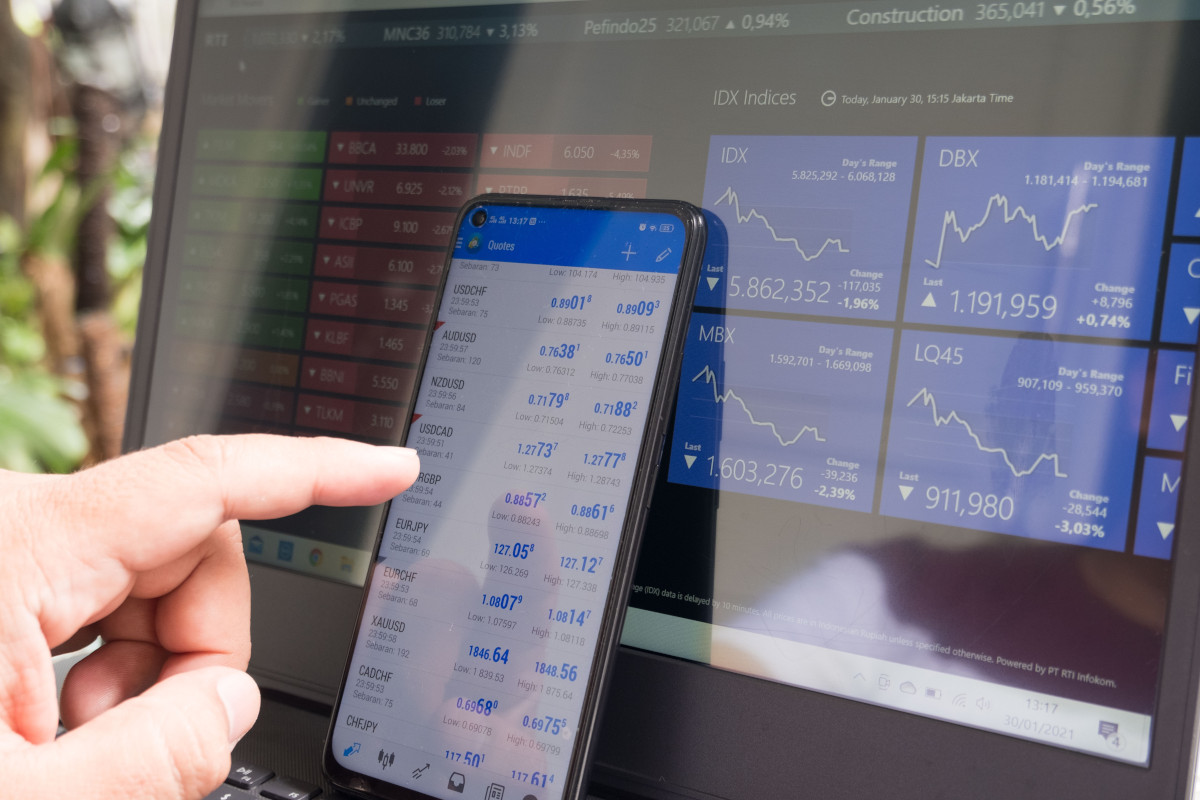You know that technical analysis plays a role in uncovering and validating opportunities, but how effective is it? Does technical analysis work, or are you better off using another means of analyzing stocks?
In this quick guide we’ll answer these questions and many others you may have about how effective technical analysis is. We’ll explain how technical analysis works, why some investors swear by it while others scoff at it, and set you up for success in formulating your own approach to technical analysis.
The best part? We’ll unveil a simpler, more efficient way to tap into the magic of technical analysis, without all the overwhelming intricacies. Through our stock analysis software, you’re given all the insights you need at a glance.
You can win more trades with less work and stress through the proprietary stock rating system we’ve developed based on both fundamental and technical analysis. More on that later. First, what exactly is technical analysis?
What is Technical Analysis?
Technical analysis, at its core, is the art and science of forecasting future price movements based on a detailed study of past market data, primarily price and volume.
It operates on the principle that price moves in trends and history tends to repeat itself. But to fully grasp the essence of technical analysis, we need to dissect it further.
Understanding the Basics: Charts, Indicators, and Patterns
At the foundation of technical analysis lie three pillars: charts, indicators, and patterns.
- Charts: These are the most basic tools for a technical analyst. They graphically represent a stock’s price movement over a set period. The most popular chart types include line charts, bar charts, and candlestick charts. Each provides a unique visualization of price movements and offers insights into potential future movements. There are line charts and bar/candestick charts – but that’s a conversation for another day.
- Indicators: These are mathematical calculations based on price, volume, or open interest of a stock or a market. Some of the most popular indicators include Moving Averages, the Relative Strength Index (RSI), and the Moving Average Convergence Divergence (MACD). Each indicator serves a specific purpose, helping traders gauge momentum, trend strength, and potential market reversals.
- Patterns: These are formations created by the price movements of stocks on a chart. Recognizing these patterns can give traders a hint about what might happen next. Classic patterns like ‘Head and Shoulders’ or ‘Double Top’ have been used for decades to predict future price movements based on historical repetitions.
We’ll dive deeper into how technical analysis works later on. First, we need to discuss the underlying philosophy of this approach to analysis.
The Underlying Philosophy That the Current Stock Price Reflects All Necessary Information
This principle is the bedrock of technical analysis. It posits that everything you need to know is already factored into the stock price, whether it’s public news, company financials, or the broader economic landscape.
This is why technical analysts focus less on why something is happening and more on chart patterns and trends that suggest what is likely to happen next. In essence, it’s the market’s collective wisdom distilled into a single, actionable price.
Remember, while this philosophy underscores the effectiveness of technical analysis, it doesn’t negate the importance of other forms of analysis. Instead, it offers a lens through which we can view and interpret market behavior, often with astonishing accuracy.
All things considered, does technical analysis work?
Does Technical Analysis Work?
The age-old question on the lips of every new trader or investor: does technical analysis work? The answer, in short, is yes.
But, as with most tools, its effectiveness is largely determined by the skill of the one wielding it. Technical analysis, grounded in the belief that history often repeats itself, gives traders a mechanism to predict potential future price movements based on historical data.
Numerous seasoned traders and financial institutions use technical analysis as a cornerstone of their trading strategy. That being said, how does technical analysis work?
How Does Technical Analysis Work?
Technical analysis operates on three foundational principles:
- Price Discounts Everything: Every piece of news, whether public or private, is reflected in the stock price. This means all events, expectations, and information – past, present, and even future – are embedded in the price.
- Price Moves in Trends: Stocks move in trends: upward (bull markets), downward (bear markets), or sideways (range-bound markets). Recognizing the start and end of a trend early can be incredibly profitable.
- History Tends to Repeat Itself: Because market movements are a reflection of mass psychology and human behavior, certain patterns and trends tend to recur over time.
Using these principles, traders employ charts, indicators, and patterns to forecast future price movements.
For instance, when a stock price breaks out of a specific chart pattern with accompanying high volume, a technical analyst might predict a particular directional movement and set trading strategies accordingly. But, why does technical analysis work for some and not others?
Why Does Technical Analysis Work for Some Individuals and Not Work for Others?
Technical analysis isn’t a silver bullet. Its efficacy varies based on several factors:
- Experience and Education: Like any skill, mastery in technical analysis comes with practice and continued education. Seasoned analysts who have spent years understanding chart nuances often fare better.
- Emotional Discipline: Even with a perfect analysis, trades can go wrong if an individual lets emotions dictate decisions. Panic selling, overconfidence, or stubbornness can be detrimental.
- Over-reliance: Banking solely on technical analysis and ignoring fundamental factors can be a pitfall. The most successful traders often use a combination of both.
- Misinterpretation: Indicators and patterns can sometimes be misread, leading to incorrect predictions. Moreover, not all recognized patterns guarantee a particular outcome; they merely suggest possible outcomes with certain probabilities.
In summary, there is always going to be room for human error, emotional decision-making, and flaws in the strategy itself. So, is technical analysis really worth using as part of your trading strategy?
So, Is Technical Analysis Really Worth It?
Absolutely. For those willing to invest the time in learning, practicing, and refining their approach, technical analysis can be an invaluable tool. It provides actionable insights that help you set a clear stock entry point and determine when to sell stocks for profit. It can be the linchpin in risk management.
However, it should be seen as part of a broader toolkit. Relying on technical analysis alone, without considering the broader market picture, can be a risky proposition. That being said, we’ll offer tips on developing a strategy that actually works below.
Tips on Developing a Technical Analysis Strategy That Works Consistently
Whether you’re following swing trading strategies, position trading strategies, market timing strategies, or even investing early for retirement, having the right approach to uncovering and validating opportunities is critical. So, let’s start with some of the most important technical trading indicators.
The Top Technical Indicators Every Trader Must Know
- Moving Averages (MA): One of the most widely used indicators, MAs smooth out price data to create a single flowing line, which makes it easier to identify the direction of the trend. The two most common types are the Simple Moving Average (SMA) and the Exponential Moving Average (EMA).
- Relative Strength Index (RSI): This momentum oscillator measures the speed and change of price movements. RSI oscillates between zero and 100. Typically, and traditionally, levels of 70 or above indicate that a security is becoming overbought, while levels of 30 or below suggest an oversold condition.
- Moving Average Convergence Divergence (MACD): This trend-following momentum indicator shows the relationship between two moving averages of a security’s price – the MACD line and the signal line.
It’s important that you’re using the best time frame for swing trading as you incorporate these indicators in your strategy. You can learn more about the best moving averages in our complete guide. But, let’s talk about actually identifying swing trading patterns through these indicators.
Pattern Recognition: Spotting Profitable Breakouts and Reversals
Recognizing patterns is at the heart of technical analysis. These patterns can provide insights into potential future price movements.
- Head and Shoulders: This is a reversal pattern, indicating a change in trend. The pattern has three peaks, with the middle one being the highest (head) and the two outside peaks being lower and roughly equal (shoulders).
- Double Top and Double Bottom: These are also reversal patterns. A double top, characterized by two peaks, indicates a potential bearish reversal after an uptrend. Conversely, a double bottom, with two troughs, indicates a potential bullish reversal after a downtrend.
- Triangles: Triangular patterns like ascending, descending, and symmetrical triangles indicate a period of consolidation before a breakout.
Backtesting or Paper Trading: The Crucial Step Before Live Trading
Before deploying any strategy, it’s essential to test its effectiveness. Backtesting involves applying your strategy to historical data and seeing how it would have performed.
This can help in refining the strategy, setting realistic expectations, and understanding its potential weaknesses.
Or, better yet, see how the strategy plays out in real-time without real money using paper trading. This allows you to simulate your strategy without the risk of losing real capital.
You can do this in the best swing trading platform: VectorVest. Speaking of which, here’s how you can simplify your approach to analyzing stocks for good…
Simplify Your Approach to Analysis With VectorVest’s Stock Analysis System!
Knowing how technical analysis works, you’re probably wondering if there’s a simpler approach. Fortunately, there is.
VectorVest is the best stock analysis app for beginner and seasoned traders alike. It’s a comprehensive system tailored for traders striving for consistent success. Here’s what it can do for you…
Transformative Trading with VectorVest
Imagine not having to spend countless hours scrutinizing over data, charts, or news – while still earning substantial trading profits. It’s possible because VectorVest streamlines the analysis, presenting you with actionable insights. How?
- Data-Driven Insights: By harmonizing both fundamental and technical analysis, VectorVest provides traders with a holistic view of potential market movements. The integration of RV, RS, and RT means you get a three-dimensional perspective of a stock’s potential.
- Tailored to All: Whether you’re a beginner swing trader just stepping into the trading arena or a seasoned professional with years of experience, regardless of if you’re swing trading vs long term investing, VectorVest adapts to your style.
- Stay Ahead of the Curve: With real-time data feeds and state-of-the-art analysis tools, VectorVest ensures you’re always one step ahead. The platform’s proactive alerts keep you informed of potential market shifts, ensuring you’re never caught off guard.
How it Works
Our system’s secret sauce is three proprietary indicators: RV, RS, and RT. Here’s a closer look at what these indicators bring to the table:
- RV (Relative Value): At its core, RV analyzes a stock’s long-term price appreciation potential. It’s a direct reflection of the anticipated price return of a security compared to a risk-free investment, say a government bond. When the RV is above 1, it signifies the stock has superior potential to outperform; if below 1, the opposite.
- RS (Relative Safety): Delving into the stability and predictability of a company’s financial performance, RS is an excellent measure of risk. A score above 1 indicates a stronger, more reliable financial track record, making it a safer bet in volatile conditions.
- RT (Relative Timing): Operating in real-time, RT gauges a stock’s immediate price direction. With a scale between 0 to 2, a score above 1 hints at a bullish momentum, whereas below 1 suggests bearish movements.
These indicators are all formulated through complex technical analysis, but they’re presented in a much simpler way – on a scale of 0.00-2.00, with 1.00 being the average. You can pick stocks with more favorable ratings to win more trades with less work!
Or, better yet, follow the clear buy, sell, or hold recommendation the system issues for any given stock, at any given time. Finding swing trading stocks and managing your position just got a whole lot easier!
Technical analysis is powerful, but it doesn’t have to be cumbersome. With VectorVest, the complexities are distilled into simple, actionable insights. It’s not just about showing you the numbers but about guiding you towards making informed, confident decisions.
So, If you’ve ever felt the weight of the stock market’s unpredictability, try the system firsthand and see what’s possible. We offer a desktop app or a mobile stock advisory so you can bring your trading strategy on the go. A free stock analysis is just a click away so you can see how it works in action.
Closing Thoughts on How Technical Analysis Works
At this point, it’s time to wrap up our guide to how technical analysis works. We’ve navigated the maze of technical analysis, dissecting its nuances, effectiveness, and the challenges it often presents.
Its principle – that price movements are not purely random and can offer predictive insights – stands strong. Yet, while technical analysis is undeniably a powerful tool, mastering it requires patience, precision, and continual learning.
This is where modern solutions like VectorVest come into play, merging the strengths of both fundamental and technical analysis while eliminating the complexities.
VectorVest doesn’t just offer numbers – it delivers understanding, clarity, and actionable insights. By streamlining the analysis process, it arms traders with the confidence to navigate the market’s unpredictable tides.
Learn more about how to analyze stocks in our blog, where we also have resources on important topics like swing trading options, where to put retirement money after retirement, what is swing trading, timing the market vs time in the market, the best day of the week to buy stocks, and more.
If you’re seeking a simplified yet comprehensive approach, the future of trading might just be a click away with VectorVest. Navigate wisely, and may your trades always find their mark!








Leave A Comment